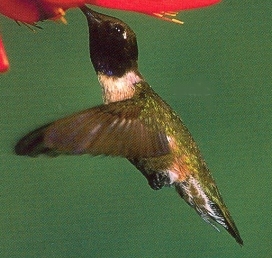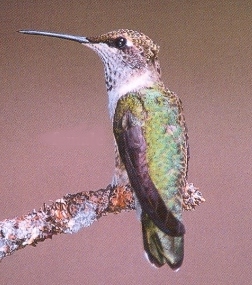|
Medium
hummingbird with metallic green upperparts, gray underparts, white breast,
green-washed flanks. Head appears black overall with white spot behind
eye; cap is very dark green. Throat is iridescent violet; bill is long
and slightly decurved. Forked tail is dark green with black outer tail
feathers.
The male Black-chinned Hummingbird has metallic green upperparts, white
underparts and green flanks. The face is black with a white spot behind
the eye and iridescent violet lower throat.
|
BLACK-CHINNED
HUMMINGBIRD
Archilochus alexandri
APODIFORMES
Hummingbirds (Trochilidae)
Range and Habitat
Black-chinned Hummingbird: Breeds from British Columbia south to Mexico
and central Texas. Spends winters in Mexico. Preferred habitats include
mountain and alpine meadows, woodlands, canyons with thickets, chaparral,
and orchards.

SOUND: "teew-teew-twee", " tchew-tchew-twhew"
In cold weather, a Black-chinned Hummingbird may ingest three times
its body weight in nectar in one day.
Their nest can expand as nestlings grow. The spider and insect silk
holding it together stretches and allows the nest to grow along with
the growing chicks.
A group of hummingbirds has many collective nouns, including a “bouquet",
"glittering", "hover", "shimmer",
and "tune” of hummingbirds.
The Black-chinned Hummingbird is a small hummingbird averaging only
3 ¼ inches long at maturity. This species is fairly widespread
in its favorite breeding areas, which include open, semi-arid land near
water. These birds are commonly found in the western United States,
northern Mexico, and southern British Columbia. They typically migrate
to Mexico for the winter, and like to feed on plant nectar and insects.
The Black-chinned Hummingbird feeds on these insects after catching
them with their wings. Due to the bird’s small size, larger birds
mistake them for insects and food.

|